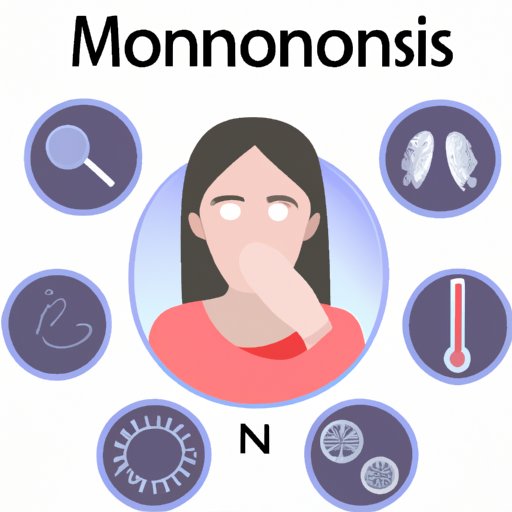
Introduction
Mono, or infectious mononucleosis, is commonly known as “the kissing disease”. It is a highly infectious condition that is spread through saliva, and affects thousands of people every year. The symptoms, which include extreme fatigue, sore throat, and fever, are often mistaken for other ailments at first. This article is intended for those who suspect they may have mono or have been diagnosed and want to learn more about the condition. In this article, we will discuss the symptoms of mono, the challenges of diagnosing it, the differences between mono and strep throat, potential complications, management tips, long-term effects, and advice on coping with the condition.
Common Symptoms of Mono
The symptoms of mono can vary from person to person, with some people experiencing few and mild symptoms while others experience severe ones. The most common symptoms include:
1. Fever: The body temperature rises above the normal 98.6°F to 100°F or higher. The fever can last up to two weeks.
2. Sore throat: A painful, scratchy feeling in the throat, particularly when swallowing.
3. Fatigue: An overwhelming sense of tiredness, even after getting enough sleep. This is often the most predominant symptom.
4. Swollen lymph nodes: Swollen glands in the neck, armpits, and groin area.
5. Rash: Small, red spots on the body, usually on the chest and back.
6. Headaches: Persistent, pounding headaches that are hard to relieve.
7. Muscle weakness: A general feeling of muscle fatigue and weakness, particularly in the arms and legs.
Challenges of Diagnosing Mono
Due to the variety of symptoms mono presents, it can be challenging to diagnose accurately. The symptoms resemble those of other conditions, such as the flu, strep throat, or even hepatitis. The condition can also be asymptomatic for months, which means that the infected person may unknowingly spread it to others.
Doctors usually diagnose mononucleosis based on the presence of symptoms and a physical exam. Blood tests that detect antibodies to the Epstein-Barr virus can indicate an infection. It can take up to six weeks for the virus to become detectable in the bloodstream, which can further contribute to misdiagnosis.
Difference between Mono and Strep Throat
Mono and strep throat can share similar symptoms. Both can cause fever and sore throat, but there are a few differences. The sore throat of strep throat is often more intense and painful than in mono, and the fever is usually higher than in mono as well. Additionally, strep throat rarely causes fatigue and swollen lymph nodes, which are more prominent in mono.
Accurate diagnosis is crucial for both. While strep throat can be treated with antibiotics, mono cannot, as it is a viral infection. Antibiotics can also make the symptoms worse in some cases.
Potential Complications of Mono
While most people recover from mono within a few weeks, some can develop complications. These can include:
1. An enlarged spleen: Mono can cause swelling of the spleen, which can rupture and lead to bleeding in rare cases.
2. Hepatitis: A swelling of the liver that can cause jaundice, abdominal pain, and vomiting.
3. Chronic fatigue syndrome: A condition characterized by extreme fatigue that lasts for at least six months.
These complications can be prevented by avoiding overexertion and engaging in low-impact activities, like walking and gentle yoga.
Managing Mono Symptoms
There are several ways to manage the symptoms of mono. These include:
1. Get plenty of rest: Sleeping and resting as much as possible are essential for recovery.
2. Stay hydrated: Drinking plenty of liquids can help alleviate sore throat and muscle weakness.
3. Pain relief: Over-the-counter pain medications like acetaminophen and ibuprofen can help with fever, headaches, and body aches.
4. Avoid Contact Sports: Activities that can cause physical trauma to the spleen should be avoided.
Long-term Effects of Mono
While most people recover from mono after a few weeks and don’t experience any long-term effects, a small percentage can continue to experience symptoms for months. These symptoms can include extreme fatigue, muscle weakness, and joint pain, which can impact daily life. In some cases, it can take months or even years for these symptoms to completely disappear. Coping with these symptoms can be challenging and may require lifestyle changes.
Conclusion
Mono is a viral infection that can cause several uncomfortable symptoms. While most people recover from it within a few weeks, it can sometimes result in long-term complications. Managing the symptoms of mono is essential, and over-the-counter remedies can help alleviate the pain and discomfort. If you suspect you may have mono, be sure to consult with your doctor to receive an accurate diagnosis and appropriate treatment.




